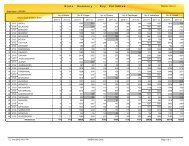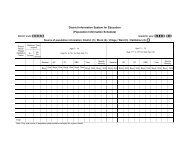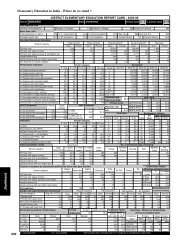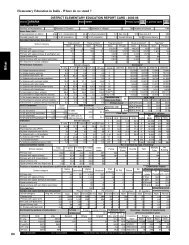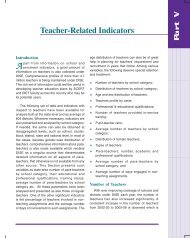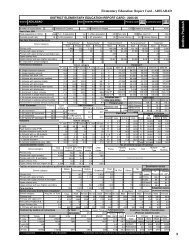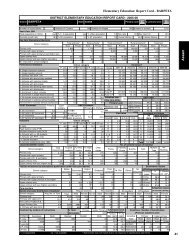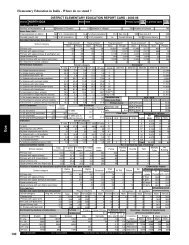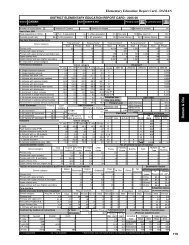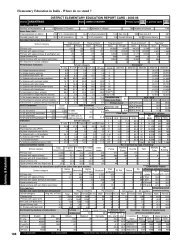Drop-out & Repetition R<strong>at</strong>es51r<strong>at</strong>e in primary classes but repetition r<strong>at</strong>e in these st<strong>at</strong>es is above 5percent. Tripura even reported above 15 percent repetition r<strong>at</strong>e, whileGujar<strong>at</strong> retained its position in the group having below 5 percent dropoutr<strong>at</strong>e and repetition r<strong>at</strong>e between 10 to 15 percent. On the other handSikkim shifted from below 5 percent drop-out r<strong>at</strong>e in 2003-04 to between5 to 10 percent during the next cohort i.e. 2004-05.A number of other st<strong>at</strong>es have average drop-out r<strong>at</strong>e between 5 to 10percent and also the repetition r<strong>at</strong>e below 5 percent or between 5 to 10percent. Jammu & Kashmir and Madhya Pradesh fall under the c<strong>at</strong>egoryof those st<strong>at</strong>es which have drop-out and repetition r<strong>at</strong>es between 5 to 10percent and below 5 percent respectively. On the other hand, AndhraPradesh, Maharashtra, Nagaland, Orissa and Punjab fall under the c<strong>at</strong>egoryhaving both drop-out and repetition r<strong>at</strong>es between 5 to 10 percent.Chh<strong>at</strong>tisgarh is the only other st<strong>at</strong>e having drop-out r<strong>at</strong>e between 5 to 10percent but the repetition r<strong>at</strong>e between 10 to 15 percent. Among the restof the st<strong>at</strong>es, Assam, Bihar, Haryana, Rajasthan, Uttar Pradesh,Uttarakhand and West Bengal reported drop-out r<strong>at</strong>e between 10-15percent in primary classes. Among these Assam and Uttar Pradesh reporteda below 5 percent repetition r<strong>at</strong>e. Except Uttarakhand, the remainingst<strong>at</strong>es in this c<strong>at</strong>egory have a high repetition r<strong>at</strong>e of 10 to 15 percent.Uttarakhand reported an average repetition r<strong>at</strong>e between 5 to 10 percent.Out of 29 st<strong>at</strong>es covered, only three st<strong>at</strong>es have an average drop-out r<strong>at</strong>eof above 15 percent in primary classes. These st<strong>at</strong>es are Jharkhand,Arunachal Pradesh and Meghalaya. However, Jharkhand has a low repetitionr<strong>at</strong>e of 5.81 percent. Except Jharkhand, the other two st<strong>at</strong>es are small insize.The distribution of st<strong>at</strong>es by average drop-out r<strong>at</strong>e and repetition r<strong>at</strong>efor the cohorts 2003-04 and 2004-05 further reveals th<strong>at</strong> eight st<strong>at</strong>eshave improved their positions in 2004-05 over their respective positionsduring the previous cohort i.e. 2003-04. These st<strong>at</strong>es are Himachal Pradesh,Karn<strong>at</strong>aka, Madhya Pradesh, Andhra Pradesh, Punjab, Chh<strong>at</strong>tisgarh, UttarPradesh and Rajasthan, many of which are large in size and crucial forthe country to <strong>at</strong>tain the st<strong>at</strong>us of universal retention. On the other hand,st<strong>at</strong>es such as, Kerala, Tamil Nadu, Gujar<strong>at</strong>, Maharashtra, Uttarakhand,Haryana, West Bengal and Meghalaya retained their respective positionsin 2004-05 over the previous cohort i.e. 2003-04. Mizoram, Tripura,Nagaland, Orissa, Sikkim, Assam, Bihar and Jharkhand, however, lost theirrespective positions in 2004-05, thus meaning th<strong>at</strong> either the averagedrop-out r<strong>at</strong>e or the repetition r<strong>at</strong>e or both in these st<strong>at</strong>es have increasedfrom their previous levels in 2003-04. Bihar and Jharkhand even reported
52 <strong>Student</strong> <strong>Flow</strong> <strong>at</strong> <strong>Primary</strong> <strong>Level</strong>an increase in drop-out r<strong>at</strong>e in 2004-05. In Jharkhand, it is as high as16.98 percent compared to 11.36 percent in Bihar. Both these st<strong>at</strong>es shouldimmedi<strong>at</strong>ely initi<strong>at</strong>e necessary steps and adopt appropri<strong>at</strong>e str<strong>at</strong>egies tocheck the drop-out r<strong>at</strong>e, else because of them, the country may not achievethe goal of universal retention <strong>at</strong> the primary level within the stipul<strong>at</strong>edtime framework.Transition R<strong>at</strong>eOne of the important indic<strong>at</strong>ors on which the expansion of upper primaryeduc<strong>at</strong>ion depends is the transition r<strong>at</strong>e from the primary level to theupper primary level of educ<strong>at</strong>ion. Two years’ grade-specific enrolmentd<strong>at</strong>a along with the number of repe<strong>at</strong>ers in the l<strong>at</strong>est year is required towork out transition r<strong>at</strong>e which is defined below:New Entrants into Grade VI in year 't + 1'Transition R<strong>at</strong>e =× 100Enrolment in Grade V in year 't'E=Et+1g+ 1t ×g100The number of repe<strong>at</strong>ers subtracted from enrolment in Grade VI or V, asthe case may be, in 2005-06, divided by enrolment in Grade V or IV in theTable 24Transition R<strong>at</strong>e from <strong>Primary</strong> (VI/V) to Upper <strong>Primary</strong>(V/VI) <strong>Level</strong> of Educ<strong>at</strong>ionCohorts: 2003, 2004 and 2005Cohort Number of Boys Girls TotalDistricts2003 461 76.01 71.98 74.152004 539 79.96 75.78 78.012005, All Areas 604 83.66 80.64 82.24Rural Areas 604 79.91 76.28 78.22Urban Areas 604 100.35 99.07 99.74previous year (2004-05) and multiplied by 100 gave the transition r<strong>at</strong>e forcohort 2004-05. Similarly, transition r<strong>at</strong>es can also be worked out for theprevious years. Transition r<strong>at</strong>e in the present study has been obtained




